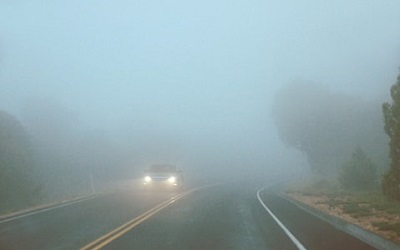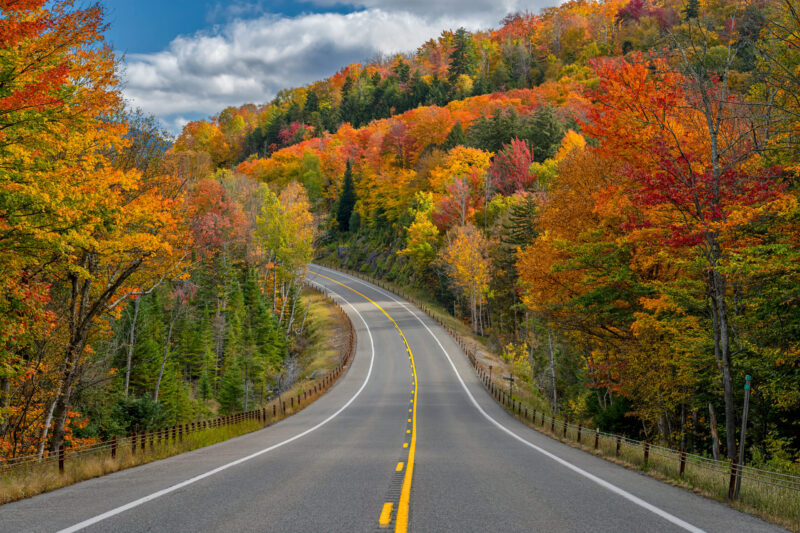Driving risk takes many forms, and the loss of visibility poses a serious one.
Although weather conditions are beyond a driver’s control, understanding the circumstances that may lead to weather events such as fog, sand and dust storms can provide some important clues about how to anticipate unusual weather events before they arise, or cope when these weather changes occur unexpectedly.
Fog is a wildly different weather event than dust and sandstorms. Sandstorms and dust storms occur in hot, dry and windy climate conditions, while fog occurs mostly in still, moisture-laden air. Yes, all three phenomena are similar in that they obscure vision—but from there, they are very different.
Impaired Visibility
Impaired visibility while driving can have two meanings:
- Your ability to see out your car’s windows and/or
- The ability of other drivers to see you, is diminished.
As a driver, you can keep your windows clear so the view from your car is not obstructed. But how can you anticipate weather events, such as severe fog or a sand or dust storm, that might rob you of the exterior visibility you and the cars around you need to navigate safely?
Understanding Fog: A Cloud at Ground Level
Fog can be considered clouds that form at ground level. Fog occurs because water vapor is present in much of the Earth’s atmosphere, and when air is very humid and loaded with invisible water vapor, that vapor can—under the right conditions—condense into liquid water droplets suspended in the air, thus forming visible fog. This can happen when warm, wet air meets a cold surface, or in the opposite conditions, when cold, wet air encounters a warm surface.
How water vapor condenses is based on two factors:
- There must be a “seed” or a nucleus in the air around which a water droplet forms. That seed usually takes the form of a particle of dust or pollution. By the sea, the seed may be microscopic salt particles.
- There must be a temperature contrast between the air containing the water vapor and a surface or body of air. For example, if warm, humid air collides with cooler air or a cooler surface, the temperature of the warm air may drop to the “dew point,” which is the temperature at which the water vapor starts to turn back into liquid water. The water condenses around the airborne particles, forming fog.
Imagine a mountain pass, warmed by the sun during the day. Temperatures drop in the evening, and that mix of warm ground air and cool, wet evening air can produce fog.
Different Types of Fog
If fog were to have a season, it would probably happen around the times of year when temperature transition between hot and cold. In the fall, for example, the warm ground holding onto summer’s heat can be suddenly exposed to a mass of cold northern air—causing fog. In the spring, the reverse can be true as thawing ground encounters a balmy air mass, carrying water vapor from the ice melt and warmed by a spring heat wave—and those conditions, too, can cause fog to form.
Ground fog forms when cold air blows over warm ground. The cold air chills the warmer, moist air at the ground’s surface, and water droplets then develop close to the ground where these two bodies of air collide. A common occurrence is fog forming over a farmer’s field, where the moisture content of the soil, grass and other plants is higher than the moisture in the adjacent roadways. This higher moisture content forms a microclimate of moisture-laden air, ripe for the formation of fog.
Trapped fog forms in valleys when cold air tumbles down from a higher elevation to pile onto warmer air, with a high moisture content, sitting (or “trapped”) in the valley. This form of ground fog most typically forms in the evening. In the morning when the sun rises, the trapped fog usually evaporates and the suspended water droplets are reabsorbed into the air as invisible water vapor. Think of morning fog hugging lower valleys of the Appalachians for a classic example.
Advection fog is found when warm, moist air meets a cooler surface or incoming body of air. The famous San Francisco fogs occur when the air over the warmer coastal landmass meets the colder air chilled by the California coastal current flowing through the Bay Area. Advection fog typically lasts until the cold air is warmed sufficiently by the heat of the day, which can take several hours, or even all day as the difference in temperatures between the warm air over land and the cold air blowing up the coast can be significant.
No matter the type, fog can be quite long-lasting, as fog rises and falls in sync with temperature differences arising from the rising or setting of the sun. In many cases, fog will evaporate during the course of a day. When the fog is very dense and there is little air motion, however, fog can settle in for several days at a time.
Understanding Sand and Dust Storms: Supercharged Windstorms
Sandstorms and dust storms are essentially windstorms that contain fine dust, silt or sand. Both sand and dust storms can carry particles in tremendous amounts, sometimes with great ferocity. Although both types of storms can obscure visibility for drivers, the sand and grit carried by blasts of air in a sandstorm are capable of scouring everything in their path. Whether a storm is carrying larger, abrasive sand or grit particles (a sandstorm) or finer dust particles (in a dust storm), both forms of windstorm can pose considerable problems for machinery, buildings, animals and humans – including drivers.
Both sand and dust storms are most likely to occur in chronically dry conditions, typically when there has been very little precipitation over a prolonged period of time. When a storm system moves into the area, a strong cold front that produces winds with no precipitation is most likely to cause a sandstorm. Sometimes the outflow from a strong thunderstorm system can create sand or dust storm conditions even when an area close by is receiving rain!
Sandstorms typically occur in desert locations or where sand is more prevalent than soil or rocks, such as in dry and flat regions like Kansas and New Mexico.
Dust storms tend to form in places where there is little vegetation and the ground is exposed to the wind, such as across the American west in areas such as Arizona. In these areas, as winds and dry climate erode the top layer of soil, the soil becomes more vulnerable to being swept away since it’s not held together by plant life, moisture and organic materials.
Whether sand or dust, how do particles on the ground get swept up to form these storms? This happens when soil or sand on the ground is buffeted by winds. If the wind force is sufficiently strong, these sand and soil particles start to tumble or jump in a process known as saltation. Through saltation, as the particles collide, they are broken up into smaller and smaller bits. Over time (which may be hours or days), the particles are fragmented until they are small enough to be borne into the sky, and a sandstorm or dust storm may result. When the conditions are right, sandstorms can arise very suddenly, forming an advancing wall of dust and debris. This wall may be miles long and several thousand feet high.
Static electricity can also contribute to these storms. In the constant agitation and vibration of the saltation process, static charges can build up on the surfaces of dust particles. Atmospheric scientists have theorized that this static electricity charge keeps the cloud of dust from collapsing, and can act as an amplifier, increasing the load of particles that any one storm can carry aloft.
Sand and dust storms seem to be getting more frequent. Observations in different areas of the world where they are most common, including the US, bear out that since the 1950s, frequency has risen as much as tenfold.
Is it Possible to Prepare for Fog, Sand and Dust Storms?
Preparing for unusual weather events and their possible consequences should be part of any driving routine, especially if you expect to drive in areas where fog or sand or dust storms might arise.
As a driver, if you can anticipate the arrival of a sand or dust storm, you will need to respond quickly. The warning signs may come fast, such as a breaking weather forecast in the affected area or seeing an advancing wall of dust or sand beyond your windshield.
For fog, drivers should monitor for rapid temperature changes when the air is humid and full of water vapor, particularly during spring and fall. The National Weather Service issues fog alerts throughout the year. Local weather reports also broadcast fog warnings. If you encounter thick fog that obscures your visibility and makes safe driving impossible, take note that usually fog settles in and persists over a three-to-four-hour period. Waiting it out may be the safest strategy.
Whether you are preparing for sand, dust or fog, the first step is making sure your car is in good mechanical condition. A well-prepared car will help you be ready for any range of circumstances where you cannot afford to be caught in a remote place. Preparing for fog and sand or dust storms means educating yourself about the conditions in which these weather events can form, then adding an extra layer of watchfulness for changing weather conditions. If you are concerned about encountering any of these unusual weather phenomena, you might consider additional supplies or equipment to keep on hand for your road trips — including physical protection for your face and body in the event of sand and dust storms, and the addition of fog lights for your vehicle if you routinely drive through areas in which fog might form.
Auto insurance can help protect you from the potentially high costs of weather-related damage. Check whether you have the right coverage—and enough of it—and purchase more if necessary. But keep in mind that while insurance can help protect your vehicle assets should you have an accident in these conditions, educating yourself so you know how to avoid an accident may be the best policy.
What You Need to Know About Driving Through Sand, Dust and Fog
Although the causes and implications of each type of storm are radically different, as are the geographies and conditions where they occur, the tips for navigating them safely are similar.
If you are caught in a sand or dust storm or fog, take the following steps:
- Drive slowly, leaving enough distance between you and other cars. This means ensuring you have enough braking distance, given the speed at which you are travelling, to avoid any hazards should you need to stop unexpectedly.
- Remain alert – no distracted driving. Keep visual and other distractions to a minimum: turn off the radio, keep your hands off your phone, and limit conversations.
- Keep your headlights on, using low beams. Your high beams may scatter into the fog or storm, creating glare instead of illumination.
- Check the weather forecast and pay attention to any advisories.
- If visibility is in question, turn on your hazard lights to make your car more detectable.
- If the conditions worsen and it is possible to move well off the road, consider doing so to wait until visibility improves. Moving off the road, and not simply to the shoulder, means you are out of the flow of traffic in the event another driver loses control of their vehicle.
There is one additional risk with sand and dust storms that is not present with fog: the risk of physical harm if you are outside your vehicle when the storm occurs. Recall that sand is used as a scouring agent – that is because a sand or dust storm is filled with sharp particles travelling at high velocity. This means that any exposed areas of your body, and especially vulnerable parts such as your eyes and ears, should be carefully protected in a dust or sandstorm. If you live in an area where sand or dust storms are common, keep some form of protection in your car—such as a scarf, filter mask to assist breathing, and proper eyewear to shield your eyes from the large quantities of airborne dust. Staying inside your vehicle is another way to shelter during a sand or dust storm.
Staying Safe, No Matter the Weather
When it comes to driving risks, impaired visibility due to weather is an important one to understand. And even though we cannot control what mother nature throws at us, there are still things you can do to help improve your situation. Be prepared. Understand the conditions that may produce fog, sand or dust storms and know the steps you can take to best deal with each of these weather events. And, don’t forget to have a firm understanding of what is and isn’t covered in your car insurance policy.







I used to live in Mendocino county California. Fog was a serious issue. I was driving a Mercedes in first gear, I could not see my hood emblem, but thank God we had fog lines on the road. I just ran at like 10 mph for a couple hours to get home. It was a wild night !o]
I read this article about driving through fog , dust & sand storms.
I was under the impression this article was very well researched and the author did a lot of scientific research about fog, dust & sand storms. I am very impressed by scientific knowledge displayed in this article in addition to very safe sounding driving tips such as : no hands on phone & pull off to side of road during these types of storms so you can be safe Off of the road to avoid collision with other driver.
Thanks for your posting. What I want to point out is that when evaluating a good on-line electronics retail outlet, look for a internet site with total information on critical indicators such as the level of privacy statement, basic safety details, any payment options, along with other terms as well as policies. Often take time to look into the help as well as FAQ segments to get a better idea of how the shop works, what they can perform for you, and in what way you can make best use of the features.